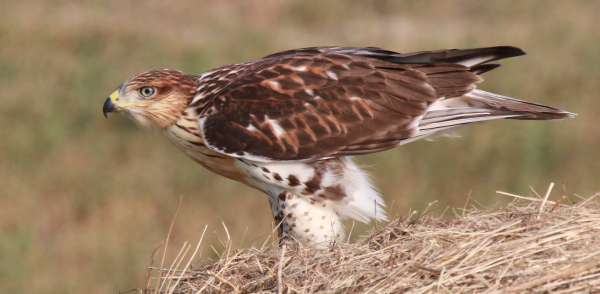
Not many people get to see newly fledged Ferruginous Hawks, which made me wonder if readers could identify one when they saw it. Ferrugs fledglings have a unique species-specific immature plumage the first year. But even a 6-month-old Ferruginous Hawk can look a bit different as their plumage fades, especially the light-orange breast that can fade into beige or white a short time after fledglings leave their home range. Therefore, when I had the chance to photograph newly fledged Ferruginous Hawks last week, I thought my documentary photos might provide some helpful insights to identifying these prairie hawks of the west.
The idea of documenting the distinctive plumages of birds at different stages that distinguish them by species, age, sex, or season is useful and important. It helps the photographer to be a better birder, and it may help others to see plumage variations in species. At the same time, this idea emphasizes the importance of taking advantage of seasonal photo opportunities and documenting what you see while birding. In this case, the Ferrug fledglings will only be in their home range for 2 to 4 weeks before moving on after learning to fly well and begin hunting for themselves, so the time is now for photographing fledglings.
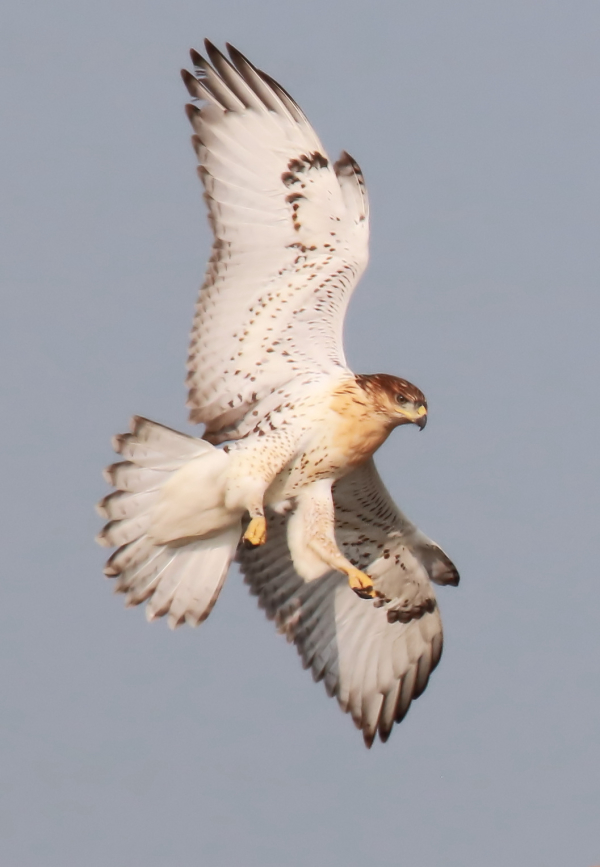
A Quick Turn
What really inspired me to develop this article was the first Ferruginous fledgling I observed near a nest site I’ve been monitoring for several years. This year, the nesting pair raised 4 nestlings, the first of which left the nest on or slightly before June 30th. When I checked back a week later, last Wednesday (July 7th), the nest was empty; but a fledgling was perched a few trees north of the nest. Actually, the young hawk was being actively harried by a male Orchard Oriole (apparently the hawk was too close to the oriole’s nest).
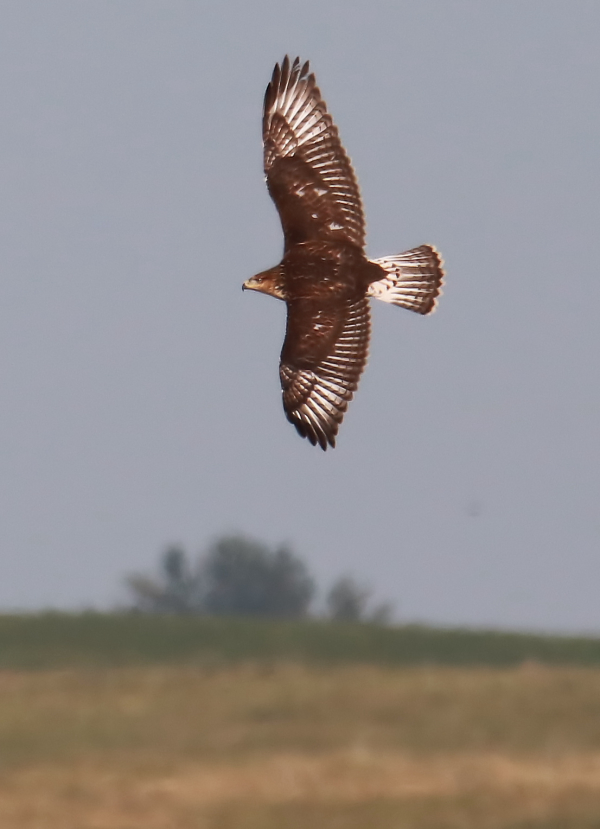
A long-range photo of a fledgling that shows its backside as it banks into a turn reveals its dark dorsal coloration with white wing and tail highlights.
|
The fully feathered fledgling was facing in my direction, prominently showing its light-orange breast plumage, so indicative of a young Ferruginous Hawk just before and after fledging. A couple quick portrait photos did the trick on a documentary level. The setting was nice, with green foliage surrounding it with a bare branch to the hawk’s right, which wasn’t ideal, but it was au natural.
To get a good documentary selection of photos of almost any bird, it would be great to get photos from the front, side, and back. Before I could give that notion a second thought, the hawk decided to turn to its side, raising its wings in the process, showing its underside, including the underside of its wings. “Excellent,” I thought as I photographed the turn in a quick series of 3 images. And, of course, as the young hawk repositioned with its wings back in relaxed position, it showed its back and its juvenile gray-and-white tail. As it turned its head to the side the fledgling hawk provided a classic view of its backside.
Really, I couldn’t have asked for more so far as the different views of a perched fledgling go; but one view was missing, a flight photo. After a short wait and some more prodding from the agitated Orchard Oriole, the young Ferrug took flight, and I was immediately impressed with the strong flight skills it showed as it winged high above the surrounding area. I followed its progress through the Tamron zoom lens, hoping the young hawk would bank, turn, and glide back in my direction, but dat didn’t happen. That’s OK I figured, there should be 3 other fledglings nearby, and I had a good hunch they might be a bit farther south where a large area had recently been hayed and baled.
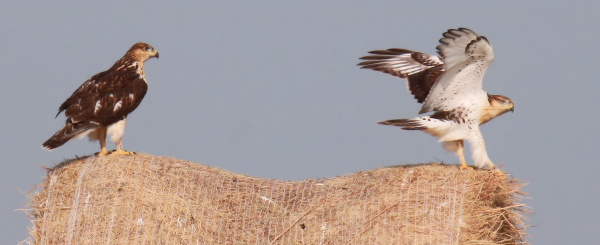
Hawk Talk
Ferruginous Hawks specialize in hunting ground squirrels and pocket gophers, and hayfields tend to have the highest populations of these small rodents, along with meadow voles and a variety of mice. These potential prey become increasingly vulnerable when the thick vegetation where they were relatively hidden as they raised their young is cut and baled, leaving them in a very different “open” landscape. Plus, at this point in the season, there are about 5 times as many of each species of rodent as young ones leave their family burrows at about the same time that the newly fledged Ferruginous Hawks are learning to hunt. The grasses, clover, and alfalfa that make up the hay crop grow back, but for the present, the hawks will take advantage of this prairie prey bonanza.
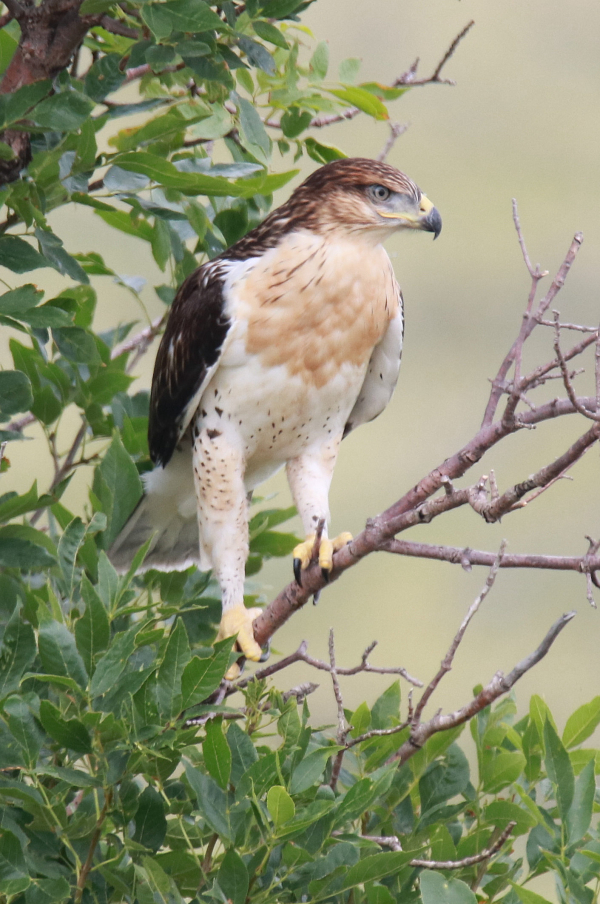
This photo and the following 2 images are the series of images that show the front, side, and back profiles of the same fledgling as it made a somewhat off-balance turn that inspired this article.
|
Sure enough, a couple hundred yards down the road, I could see 2 fledglings atop one of the big round bales – one standing and one lying. I took a couple initial photos, zooming in to get closer images, then zooming back to take photos that showed the full size of the bale and something of the surrounding field and hillside. Almost immediately the big adult female Ferrug dived into the scene, screaming her war cry in my direction; followed by the male that glided twice as high overhead. I didn’t want to disturb the family group, so I vacated the area.
I’ve studied nesting Ferruginous Hawks for decades, and I’ve monitored nesting behavior and nesting success at several hundred nests – about 700 nests – so I know the species intimately on their nesting range, and not just in Dakota. I also studied and described the post-fledging period of the species within the home range surrounding several nest sites, and published a research paper with my associate and mentor Dave Gilmer (Post Fledging Behavior of Ferruginous Hawks by Konrad and Gilmer, published 1986 in Raptor Research 20(1):35-38. So these fledglings are not new to me, but they are no less interesting to observe and photograph. In fact, I have a stronger bond with members of this raptor species, and I’m glad to share that connection with you here and through the accompanying photos.
I share that information to underline that I understand these hawks and their behaviors intimately, so I’m always concerned for their welfare, especially during the critical post-fledging period when they must quickly learn to fly and hunt on their own while still being fed and protected by the adult pair within their nesting range. It’s not all about getting a photo; first, it’s about not disturbing the birds. But when the situation is right, and the birds are in a position where I feel safe to photograph them from a distance, I make the most of the opportunity. Using a long camera lens, such as the Tamron 150-to-600 zoom lens I’ve been using, helps me keep a safe distance between me and the birds.
Varied Sunlight
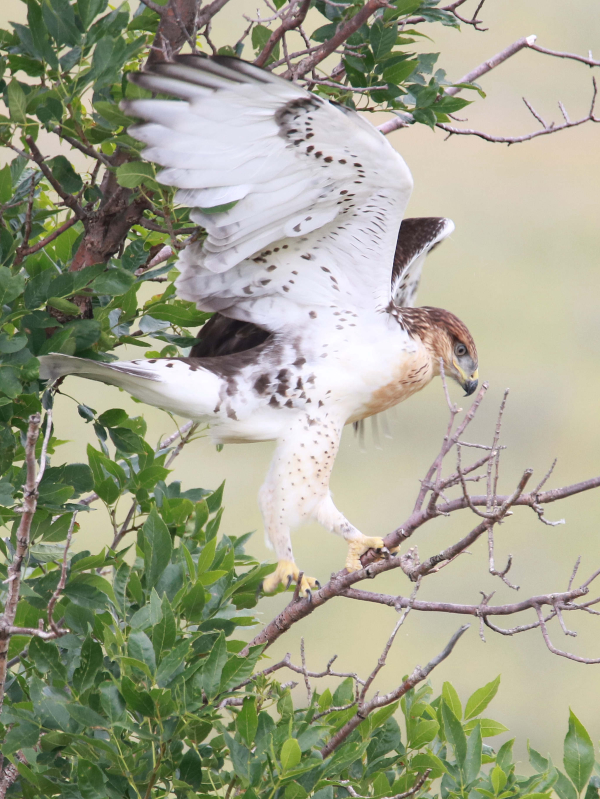
This 3-photo series was taken during subdued sunlight caused by high clouds, which reduced the effect of shadows but still provided pleasing colors. The photos were taken with an aperture of f6 and 1/500 shutter speed.
|
As you know, I always prefer direct sunlight while photographing birds, with the sun behind me and the birds before me when the sun is at a 60- to 30-degree angle above the horizon. That was the case over the weekend, when I photographed the hawks and the resulting photos show bright colors created by natural sunlight.
But during the eventful afternoon when I photographed the first young Ferruginous Hawk, high clouds shielded the sunlight, which worked in my favor to a degree. I checked in on the hawks an hour or 2 before I would normally consider prime photo time (6 to 8pm now), therefore the light clouds eliminated shadows yet provided full colors. It wasn’t obvious the colors would be bright and accurate, but I was pleased with the quality of the initial series of 3 photos that showed the fledgling’s coloration from the front, side, and back.
Under both sunlight conditions, there was adequate light to use fast shutter speeds to stop action, and choose the best apertures to provide broad or narrow areas of focus around the hawks. As usual, I used an ISO of 400, which reduces the perceived grain in resulting photos while providing the basis for variations I chose in aperture and shutter speed under varied conditions. I also use the Av (aperture-setting), which allows the camera to automatically select the corresponding shutter speed under the current light conditions. Then, I can always change the aperture (f-stop) to attain the preferred shutter speed, knowing aperture and shutter speed are always a bit of a compromise in bird photography – a give and take.
Return for Sunlight Flights
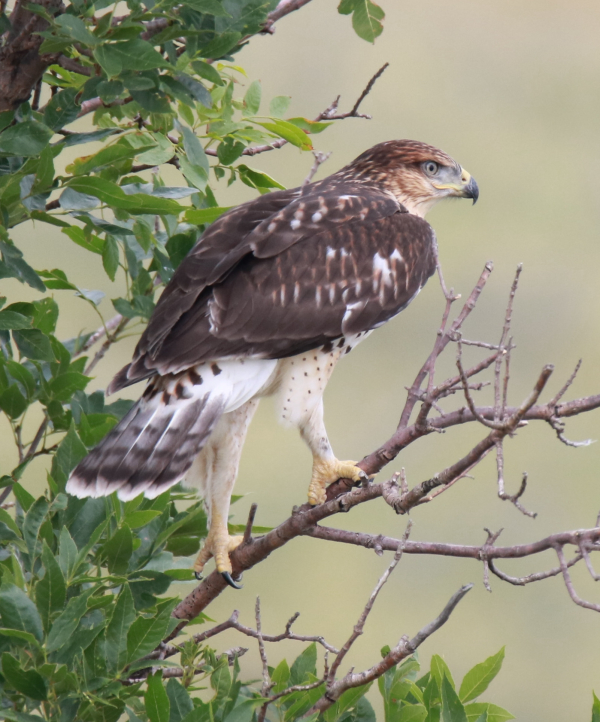
It’s a great time of year to document fledglings, but with due caution not to disturb the birds during this important period when they learn to fly and find food on their own. It’s also a great time to share the fruits of your photo efforts in the field with others.
|
I made it back to the hawk nest site during the next sunny day, Saturday, at the prime sunlight time of 6:20pm. Almost immediately I encountered one of the fledgling Ferruginous Hawks perched next to the road atop a large round bale in perfect light. I could see the road was vacant for miles in both directions, so as I approached the young hawk I turned off the engine and coasted silently into position to photograph out the window of my mobile blind at will. The fledgling was handsome and trusting, and I appreciated the opportunity to take some sharp portrait images in close quarters, then slip away without disturbing the hawk.
That was my only photo option among the hawks that evening, but with similar sunshine on Sunday, I had to return with the hope of getting a flight photo, which the fledgling hawks had denied me up to that point. This time, during prime sunlight (6:30pm) 2 of the fledglings were actively flying above the hayfield, and I pulled into position near a big hay bale where 2 other fledglings were perched. I photographed the young hawks standing on the bale, then witnessed what appeared to be something of a tag team flight exercise: One fledgling took flight and made a broad sweeping circle that brought the hawk back to the bale; and as soon as one fledgling landed into the south wind, the other took flight and followed a similar flight path and circled back to the bale. This activity created just the opportunity I was hoping for, and provided flight photos that I could only dream about until I saw them on my camera screen.
As the first fledgling dipped low during its circular flight, I could see that it might be returning to the bale, so I focused on the bale and waited a moment. Sure enough, the young hawk banked into the wind with its wings and tail widely spread and dropped its legs in advance of landing on the left side of the bale. As the hawk banked, I began taking a series of photos, and share the best to illustrate a fledgling in a dramatic flight position.
The second fledgling provided a long-range image of its topside as it banked partway through its circle flight, which provided a view of the fledgling I hoped to document. We often see these hawks’ underside in flight, but rarely their dorsal side. As the second fledgling continued its circuit, it provided a similar opportunity to take photos as it approached the bale and passed the first fledgling to land on the right side of the bale. As exciting as it was to photograph the flight action, it was a little comical to see the second bird as it landed on the right edge of the bale, almost over-shooting the edge before regaining its hold on the bale and its balance. It was testament that these young hawks were good fliers, but they were still practicing the details of flying and landing.
The fledgling Ferrugs seemed to relax a few moments, then took off in tandem, winging east over the hayfield in impressive fashion. The young hawks really gave me a great surprise photo opportunity, and the resulting images sure fit in with my original simple descriptive photos and added some excitement, action, and gusto to the photos I can share with you here. The flight photos also show how it’s nice to try building on a theme: While documenting the identifying characteristics of fledglings, you can improve on the initial images you take with some additional follow-through and luck.
Today I’m sharing my observations and photographs of one species of birds during their post-fledging period, but I offer it as an example of how you can try to document a species you encounter in a similar manner. The opportunity may present itself during a single interaction, or it may take days or weeks of monitoring and managing to get photos during different days afield. It’s a valuable way to study and learn more about a species, and even individual birds; and along the way, with a bit of persistence and luck, you should get some impressive photographs to be proud of and that you can share with others. For me, it’s one of the highest levels of birding, and it pays off in a variety of ways, including a sense of satisfaction and accomplishment. And then there are the thrills of experiencing and photographing birds as they naturally.
Article and photographs by Paul Konrad
Share your bird photos and birding experiences at editorstbw2@gmail.com